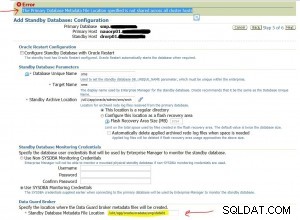Hier ist ein Beispiel für eine solche Abfrage:
SQL> create table t (site_id,start_date,end_date)
2 as
3 select 1, date '2008-10-01', date '2008-10-02' from dual union all
4 select 1, date '2008-10-02', date '2008-10-03' from dual union all
5 select 1, date '2008-10-03', date '2008-10-30' from dual union all
6 select 1, date '2008-10-30', date '2008-10-31' from dual union all
7 select 2, date '2008-10-01', date '2008-10-02' from dual union all
8 select 2, date '2008-10-02', date '2008-10-03' from dual union all
9 select 2, date '2008-10-03', date '2008-10-04' from dual union all
10 select 2, date '2008-10-04', date '2008-10-05' from dual union all
11 select 2, date '2008-10-05', date '2008-10-06' from dual union all
12 select 2, date '2008-10-06', date '2008-10-07' from dual union all
13 select 2, date '2008-10-07', date '2008-10-08' from dual union all
14 select 2, date '2008-10-08', date '2008-10-09' from dual union all
15 select 2, date '2008-10-09', date '2008-10-10' from dual union all
16 select 2, date '2008-10-10', date '2008-10-11' from dual union all
17 select 2, date '2008-10-11', date '2008-10-12' from dual union all
18 select 2, date '2008-10-12', date '2008-10-13' from dual union all
19 select 2, date '2008-10-13', date '2008-10-14' from dual union all
20 select 2, date '2008-10-14', date '2008-10-15' from dual union all
21 select 2, date '2008-10-15', date '2008-10-16' from dual union all
22 select 2, date '2008-10-16', date '2008-10-17' from dual union all
23 select 2, date '2008-10-17', date '2008-10-18' from dual union all
24 select 2, date '2008-10-18', date '2008-10-19' from dual union all
25 select 2, date '2008-10-19', date '2008-10-20' from dual union all
26 select 3, date '2008-10-01', date '2008-10-02' from dual union all
27 select 3, date '2008-10-02', date '2008-10-03' from dual union all
28 select 3, date '2008-10-03', date '2008-10-04' from dual union all
29 select 3, date '2008-10-04', date '2008-10-05' from dual union all
30 select 3, date '2008-10-05', date '2008-10-06' from dual union all
31 select 3, date '2008-10-06', date '2008-10-07' from dual union all
32 select 3, date '2008-10-07', date '2008-10-08' from dual union all
33 select 3, date '2008-10-08', date '2008-10-09' from dual union all
34 select 3, date '2008-10-09', date '2008-10-10' from dual union all
35 select 3, date '2008-10-30', date '2008-10-31' from dual
36 /
Tabel is aangemaakt.
Und dann die Abfrage:
SQL> select site_id
2 , min(start_date) contiguous_start_date
3 , max(end_date) contiguous_end_date
4 , count(*) number_of_contiguous_records
5 from ( select site_id
6 , start_date
7 , end_date
8 , max(rn) over (partition by site_id order by start_date) maxrn
9 from ( select site_id
10 , start_date
11 , end_date
12 , case lag(end_date) over (partition by site_id order by start_date)
13 when start_date then null
14 else rownum
15 end rn
16 from t
17 )
18 )
19 group by site_id
20 , maxrn
21 order by site_id
22 , contiguous_start_date
23 /
Und die Ergebnisse:
SITE_ID CONTIGUOUS_START_DA CONTIGUOUS_END_DATE NUMBER_OF_CONTIGUOUS_RECORDS
---------- ------------------- ------------------- ----------------------------
1 01-10-2008 00:00:00 31-10-2008 00:00:00 4
2 01-10-2008 00:00:00 20-10-2008 00:00:00 19
3 01-10-2008 00:00:00 10-10-2008 00:00:00 9
3 30-10-2008 00:00:00 31-10-2008 00:00:00 1
4 rijen zijn geselecteerd.
Viele Grüße, Rob.




